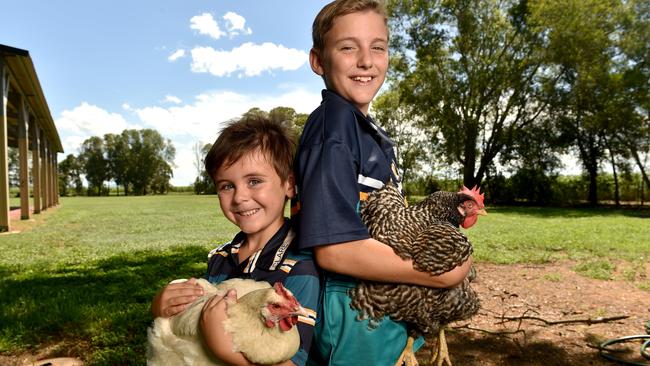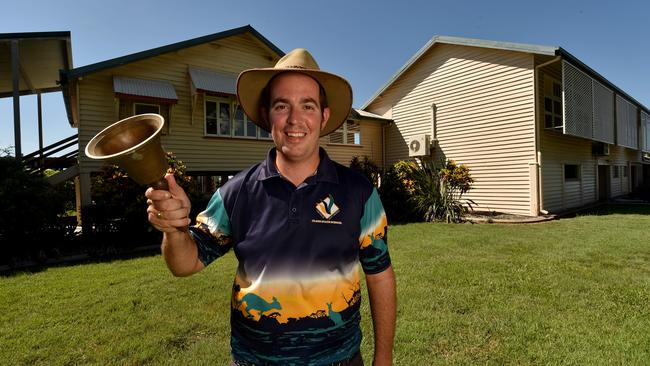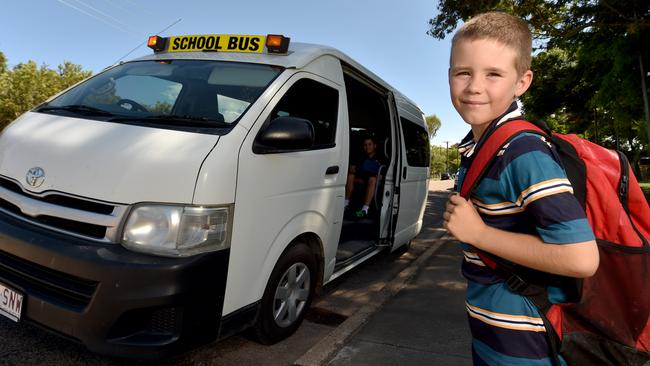Students learning real-world hands-on knowledge at Clare SS
While enrolment numbers are at their lowest in six years, the principal says the teacher-to-student ratios mean their kids are thriving as we look inside one of the region’s smallest schools.

Townsville
Don't miss out on the headlines from Townsville. Followed categories will be added to My News.
When the lunch bell rings at Clare State School, students hurriedly eat their sandwiches to feed their scraps to the school’s brood of chickens and check for fresh eggs to take home.
The small school sits in the heart of a close-knit rural sugarcane farming community, 35km west of Ayr.
Its official 2020 enrolment was 13 students, from Prep to Year 6.
The school was last year among 128 schools across the state with a population of 21 students or less – 10 per cent of all Queensland state schools.
School principal Troy Patti has been at the school for three and a half years and works alongside a full-time teacher, a part-time teacher and three teacher’s aides.
While enrolment numbers are at their lowest in six years, Mr Patti said the intimate school environment was what made the school so special.
RELATED
• Thuringowa State High School recognised for pioneering program
• Edmund Rice Education announced plans to ‘put down roots’ in the Burdekin
• With 2 national and 30 state titles, Kirwan’s sporting reputation is profound

“The beauty with the small school system is we work very closely to collaborate on the students’ learning,” he said.
“You have those personal relationships with the kids and their families and it goes a long way to get the best outcomes for the kids.”
Clare is proud to host the annual Burdekin Small Schools Athletics in August when 200 students from 11 schools across the region come together to compete.
Mr Patti said the cluster of small schools in the Burdekin and Dalrymple regions worked closely to improve methods of teaching throughout the year.
“We work around certain subjects like music, art and science so it makes it easy for us to bounce ideas off each other for curriculum.”
The cluster of schools was recognised for their learning strategies in 2019, winning the Showcase Award for Excellence in Rural and Remote Education.
Mr Patti said the schools’ collaboration had seen an improvement in their students’ NAPLAN writing data from 2018 to 2019.
“When compared against the rest of the state, the students at our school going from Year 3 to Year 5 improved by more than the state average,” he said.

Australia’s top teachers’s aide
Clare State School is also the home of an Australian Teacher’s Aide of the Year, with Lyn Corradi awarded the prestigious honour in 2018.
Ms Corradi has been the school’s teacher’s aide for 13 years and said her job played a big role in supporting the small school.
“At a small school you find you become family and I love watching preppies go to Year 6 and if we see a child that is struggling we put things into place to help the kids,” she said.
Teacher-student ratio a plus
This year, the teacher to student radio is sitting at 1:4, offering a clearer focus on students’ work and individual teacher goal setting practices.
“There is no way the students fall through the gaps with the staff to student ratio so having those close connections with the kids, there is nothing they miss out on.”
Mums and dads play role
Families are also heavily involved in school life and their children’s learning, helping with reading rotations and literacy groups. The school conducts opinion surveys with parents, staff and students every year to determine how the student is “growing socially, emotionally and academically”.
Mum of three Pippa Tomasetig has volunteered as the school bus driver for 11 years, also spending one morning a week helping the students with their reading and literacy.
With her youngest child in Year 6 this year, Ms Tomasetig said she had religiously provided feedback to the school over 12 years so the principal “knows where to make improvements”.
“For example, a few years ago we felt it was important that the school needed to move with the times and have a bit more online availability,” she said.
The principal said the close community culture extended beyond the school gates as well.
“We had a new garden installed two years ago and most of the plants, rocks and cement was donated,” Mr Patti said.
“What blew me away was two fathers came in with a backhoe to put the sand into our sandpit and by the time they had finished, they had three people turn up that had driven past the school and got their shovels out and start shovelling sand even though they had no connections to the school.”

The school receives funding from a range of grants each year including the Digital Literacy School Grant, Learn to Swim program and Investing for Success fund.
A quarter of its total funding comes from the department’s School Appropriation grant, which last year was $25,000.
If there was one area of struggle, Mr Patti says it’s convincing young families to send their prep-aged children to the school.
“They see the size of the school and think that it is not big enough for their child but there is the opportunity to socialise and make those connections with the kids,” he said.
Being in the Burdekin, the small school inevitably has a strong focus on agriculture.
The students are taught how to hatch and look after chickens, also cultivating a vegetable patch as part of their school curriculum.
Once a full carton of eggs is collected and vegetables picked, students nominate who gets to take home the fresh produce.
Mr Patti said the school curriculum incorporated practical learning subjects and lessons.
“With a small school you definitely have opportunities to make learning hands on and all the kids are involved because with small group work you get through your lessons quickly,” he said.
Originally published as Students learning real-world hands-on knowledge at Clare SS
